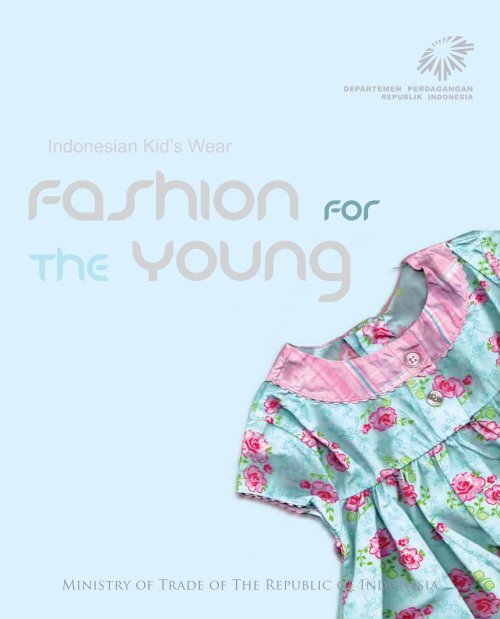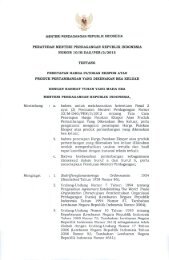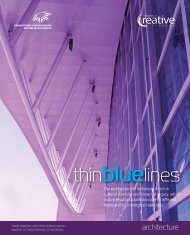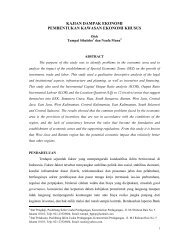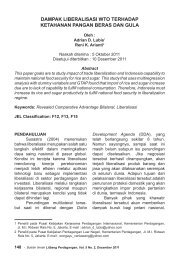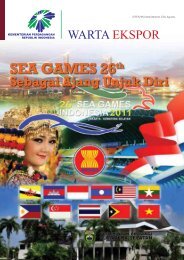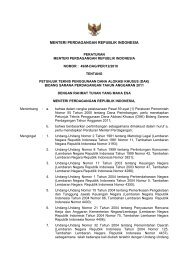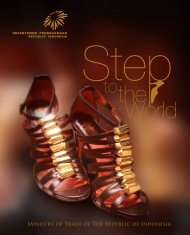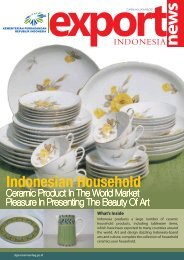Create successful ePaper yourself
Turn your PDF publications into a flip-book with our unique Google optimized e-Paper software.
<strong>Indonesian</strong> Kid’s <strong>Wear</strong>15<strong>Indonesian</strong> KidswearMinistry of Trade of The Republic of Indonesia
Commodity Profile16<strong>Indonesian</strong> Kidswear
17<strong>Indonesian</strong> Kidswear
IntroductionTo introduce a number of Indonesia’s potential products which are spread in over Indonesia region,TREDA has organized a series of effort to collect and analyze the relevant information related to the potentialsand specific advantages of each of the products.With pride and joy, TREDA offers this booklet, entitled “<strong>Indonesian</strong> Kidswear: Fashion for the Young“, toreaders who wish to know more about the relevant information. Indonesia is a country with rich culturalheritage and advance craftsmanship, but also a society with significantly young and modern population.This booklet presents an exploration of the history and characteristics of kidswear as well as its splendorand ingenuity.Indonesia, with a rich cultural heritage offers the world variety of stylish kidswear for the people toenjoy. The readers will find interesting background information around this attractive product. A bettercomprehension on its background will enhance the readers’ awareness and knowledge of these attractive<strong>Indonesian</strong> clothing products.We sincerely hope that readers would enjoy this booklet as much as we have in preparing for its publication.18<strong>Indonesian</strong> KidswearMuchtar DDirector GeneralTrade Research and Development Agency (TREDA)
Minister of TradeRepublic of IndonesiaMessageIt is our great pleasure to share with you one special type of numerous product lines belonging to<strong>Indonesian</strong> creative industries, in this particular case, kids’ fashion wear. As a country situated at thecross-road between two oceans and two continents, <strong>Indonesian</strong> culture displays a unique mix shapedby long interaction between original indigenous customs and multiple foreign influences. The creativityof <strong>Indonesian</strong> people has given birth to numerous attractive art forms.Over the last five decades, <strong>Indonesian</strong> textile and textile products industry has grown from a smallsector to a major contributor to Indonesia’s total industrial output. The government has categorizedtextiles and clothing as a strategic industrial sector. In the past 20 years, along with the garment industry’ssuccessful market, <strong>Indonesian</strong> kid’s fashion and wear have been growing very fast too. The governmentin collaboration with The <strong>Indonesian</strong> Textile Association (API) has been constantly providingsupport and assistance in developing and promoting the garment industry to serve global demands.As part of our national efforts at improving <strong>Indonesian</strong> share in the world market, this booklet presentbackground information on <strong>Indonesian</strong> children fashion for the readers to appreciate. Enrichedwith vivid illustrations, this book is dedicated to those who are interested in exploring the richness andeconomic potentials of children fashion.Mari Elka Pangestu19<strong>Indonesian</strong> Kidswear
20<strong>Indonesian</strong> Kidswear
C O N T E N T S21<strong>Indonesian</strong> Kidswear
22<strong>Indonesian</strong> Kidswear
Adorable Clothing<strong>Indonesian</strong> costumes in the past were very much influencedby its nature, culture, religion and its tropical climate.Since earlier time, <strong>Indonesian</strong>s had already had variouskinds of designs for their costumes.To most <strong>Indonesian</strong>s, kids or children are reflection of good luck and symbol of happiness.They are loved and protected, respectively decorated by beautiful and comfortable clothes; eachcountry in the world has different way on how parents cover and wrap their babies and children.As their skins are soft, mothers gently try to keep their babies warm and comfortable with softcloth as they can afford to get.In this naturally rich country, children and babies are decorated in different kind of clothing.Indonesia is furnished with vast rain forests, mountainous villages, exotic beaches and variouscultural beauty of its people. The cities are spread around the isles picturing unique blend of eastand western architecture. Modern and traditional ways of attire is one of the attractions found indifferent cities and villages.<strong>Indonesian</strong> costumes in the past were very much influenced by its nature, culture, religionand its tropical climate. During the ancient time, like many other nations, to protect their bodyfrom extreme weather and other features of the environment, people wore animal skin or lightwooden skin. Eventually they started to wear rough cotton; however they were keen about theircostumes especially for the religious purpose.<strong>Indonesian</strong> modern clothing for men and women are much influenced by the Dutch colonialoccupation when the <strong>Indonesian</strong> women at that time were introduced to portable desk and footpedaledsewing machine.Since then, western style clothing began to spread firstly among the high class society butlater after the <strong>Indonesian</strong> independence the style was adopted by urban people in big cities.Even though Batik wrapped skirt and kebaya (blouse) had become the traditional dress for women,since 1950 most of young women and kids have worn western dresses and starting from the1960s almost all of <strong>Indonesian</strong> kids wear western style clothing in the cities as well as in villages.1<strong>Indonesian</strong> Kidswear
In the garment world, Babies are meant from 0 to 18 months, and Kids are those from 18months to 12 years. Babies’ wear is garment for babies whose ages are 0 to 12 or 18 months.Kid’s wear is categorized as garment for children whose ages are from 18 months to 12 or in somecases 14. Internationally, the classification used for this group of ages in most countries does notdistinguish between men’s and boys’ clothes or between women’s and girls’ clothes. However,Baby’s clothes are given their own classification numbers which are Harmonized System 6111and 6209.Over the last five decades, <strong>Indonesian</strong> textile and textile products industry has grown from asmall sector to a major contributor to the country’s total industrial revenue. The country’s governmenthas categorized textiles and clothing as a ‘strategic industrial sector’, playing an importantrole in the nation’s economic development. The industries are absorbing a great number ofworkers and giving substantial contribution to the foreign exchange reserves.Textile industry in Indonesia has grown more than 40 years. It made the firstmove through home industry in 1960s, and grew to supply domestic market inthe 1970-80s. Later in 1990s the textile and textile industry began to enter exportmarkets. The sector is still giving substantial contribution to the foreign exchangereserves.Along with the success of the textile industry, <strong>Indonesian</strong> Kid’s wear whichis part of the textile industrial products have been growing very fast too.A lot of international kid’s wear manufacturers from developed countriessource their product manufacturing through big <strong>Indonesian</strong> companiesin some provinces like West, Central and East Java. These internationalbranded garments produced by local factories are then exported tosome other overseas countries.2<strong>Indonesian</strong> Kidswear
The Colors of FashionFashion Design<strong>Indonesian</strong> designers have rich cultural gifts inherited by artists of ancient time. Their creativitiesare inspired by hundreds of traditional ethnic apparel spread in almost 17,000 islands of<strong>Indonesian</strong> archipelago. In the last few decades they have produced modern designs in textile aswell as garment production to meet the demands of local buyers. New designs from the westernworld have also enriched their creativities in catching up with International designs and fashion.The creativity of <strong>Indonesian</strong> designers are very much influenced and supported by economicand technology development progress such as the local textile production, fast developed mediaand communications (like televisions and cable TV, printed materials, computers and theinternet), fashion show, trade exhibitions, education, trade missions, tourists industry, etc. Fashionhouses and their associated fashion designers, as well as high-status consumers (includingcelebrities) appear to have some role in determining the rates and directions of fashion change.Age, Sizes and GradingKid’s wear have very short life cycle as kids grow fast within months, so good and comfortablesizing system are important. As discussed earlier kids are defined as children up to the age of12 or 14. Babies are new born up to 18 months. The most sizing system are based on how tall achild is, or in some European countries is called “Centilong”. The sizes start from 56 cm and go to171 cm. But babies’ wear are often sized by age, i.e. months, instead of by “Centilong”. Some designersand manufacturers often have conversion tables which show the size which correspondswith the age of average children. Since European and American children tend to be bigger than<strong>Indonesian</strong> children, most often the <strong>Indonesian</strong> manufacturers and exporter adjust the size tothe buyers’ sizing system and specifications.Trend and ClimateAs summer, or rather, dry season in Indonesia lasts throughout the year; the climate doesnot very much affect the styles, materials and designs. Clothes designed for local consumptionare light and mostly made of cotton. Garment to be exported to countries like USA, Europe andAustralia are customized to the buyers’ requirements and specifications, which suitable for thecold and wet season, they are usually heavy garment, such as jacket and winter coats.3<strong>Indonesian</strong> Kidswear
ColorsParents always want to decorate their kids since they were babies. Even before they wereborn to the world, parents, especially the mothers, have already bought various things and accessoriesfor the coming babies. Designers know well about parents’ desire to decorate babies,toddlers and older kids by facilitating good and cute designs with suitable soft colors. Selectionof colors is important for the babies and Kid’s, soft and cool colors are dominating the kid’s fashiondesigns.Important issues in children’s or kid’s fashion may include types of materials, comfort, designs,color, size and trends. Kid’s fashion can be categorized into girls and boys and age group,sport and casual, pants and skirts, blouse, jackets, dress and school dress.Types of Kid’s Fashion GarmentHaute CoutureHaute couture or high quality and exclusive custom-made clothes in Indonesia israther applicable for adult of high class society than for children. But good and qualifieddressmakers and tailors for kids are available in big cities; they can give adviceand help make dresses for anybody with individual designs and reasonablecosts. It is a common practice for <strong>Indonesian</strong> middle class society to havecustom-made clothes, even it is not categorized as haute couture art worklike in the modern world, where sense of luxury is more emphasized, buthere, it is more as a craftsmanship of local experts with individual taste.Recently, several <strong>Indonesian</strong> top designers are starting to specializethemselves as Kid’s fashion designers who design custom made dresses orsuits for kids. Department Stores and Fashion Boutiques are beginning tohire fashion designers for special market segments that tend to consumehigh quality dresses or suits for kids. They believe customers who havespecial attitude towards fashion and life style tend to buy higher pricedfashion clothes.4<strong>Indonesian</strong> KidswearReady-to-<strong>Wear</strong>Massed garment production or confection collection of kid’s garmentis more commonly seen all over the places in Indonesia. Factoriesin big cities like Jakarta, Bandung, Semarang, Surabaya and Denpasarare known as Kid’s ready-to-wear products centers. Nowadays a lot of
Kid’s ready-to-wear garment are exclusive branded products which carefully designed by localor international designers. Some brands are produced by foreign companies that source the productionthrough <strong>Indonesian</strong> garment factories such as Gap, Levies, Body & Soul, Talbots, Havengirl,etc. and some other comes genuinely from domestic companies with either local or foreigndesigners such as Kutakidz, Koopu Kidz, Indigo, Mama & Leon, Le Monde, Suzane, Yuspoti, Yenyen,Venice, and many other.Product characteristics of Babies garment include jackets, coats one or two pieces suits, trouser,dresses, pullover, blouses, T-shirts, caps, sets, gloves and socks.Girls and BoysApparently garment designers and factories produce both girl’s and boy’s clothes, even inreality there are more girls’ fashion dresses easily available everywhere. It shows that girls fashionis a little bit ahead compared to boys, since boys’ fashion stay longer than girls’.Sport and CasualMost commonly kids’ clothes are designed as casual or sport styles outfits. This is because kidsspend most of their time playing and they are extremely mobile. For both girls and boys, therehas been a switch over the past several years towards purchasing sport and sport leisure typewear as casual clothing, with the majority of children’s wear classed as casual.Dress and School DressChildren fashion usually consists of dress and party dress for girls or formal outfits for boys.There are dresses suitable for schooling too, however most of the schools in the country obligekids to wear school uniforms which is usually massed produced as confection.5<strong>Indonesian</strong> Kidswear
Pants, Skirts, Blouse and JacketIn the early stage of Kid’s fashion in Indonesia people tended to produce more formal dressfor girls, but now girls wear pants, skirts, blouse and jacket most of the time, just similar with thetrend in the western countries, where children purchase mostly casual garment. As the textileand garment companies produce large quantity of cotton including jeans, the garment companiesconsume a lot of cotton materials, especially jeans for casual pants which are popular amongthe kids. The popularity of casual kid’s wears has also increased the demands for knitted productslike T-Shirt, sweaters, jumpers, cardigans, etc.MaterialsProducing Kid’s <strong>Wear</strong> needs special attention on the material selection. Designers wouldknow what kind of materials suitable for kid’s wear so that it would be comfortable for kids tomove during their mobile activities. Materials commonly used by <strong>Indonesian</strong> manufacturers are:wool, cotton, knitted crocheted, knitted cotton, rayon, corduroy, drill, denim, microfiber, talon,satin, silk, linen, synthetic fibers and velvet.Indonesia is a textile producing country; raw materials supplies for garments manufacture,such as textile and clothing accessories for the production are available locally. There are manyyarns, fibers, fabric, weaving, knitting factories that can supply raw materials for garment industry.Numbers of companies that produce polyester filament yarn aremostly in West java and Banten; among others are Indo BaratRayon in Purwakarta, Polysindo Eka Perkasa in Semarang,Kahatex, Bintang Agung and Argo Pantesin Bandung. Their capacities are between40,000 – 76,000 tons per year.6<strong>Indonesian</strong> KidswearThe materials for Kid’s wear haveto be safe to wear and play, especiallyfor children up to 3 years and forolder ones. Some countries havespecific standards for examplecords, must be stitched to garmentso a child can not harmitself playing with a loose cord. Thatis why the selection of materials is reallyimportant.
ProcessingThe initial preparation done by major garment manufactures prior to the production processwould include important management tasks concerning: raw materials, design analysis, cuttingproduction analysis, sewing production equipment, packaging and warehousing, productionand quality control, purchasing and inventory control, marketing, etc. Below are the basic stagesof the fashion garment production process:1. Garment design and selection by the designer and buyer2. Fabrics and trimmings selection by cloth buyer3. Patterns designed and cut by pattern designer4. Lay plan created by pattern designer5. Fabric cut by cutter6. Garment assembly by garment machinists and operatives7. Garment finishing by finishing operativesIn garment production, especially in major manufacturers, there are a couple of basic productionsteps. Initially, the designer and buyer would select garment designs. Then the cloth buyerwould select the fabrics and trimmings. After that the patterns designer would make the designand do the cut and create the lay plan. The cutters finally cut the fabric which is then assembledby the garment machinists and operators. Finally the finishing touch would be done by finishingoperators.In terms of machines, there are number of large and modern <strong>Indonesian</strong> garment factoriesare now using sophisticated machineries well equipped with advanced computer system. Evensome of the smaller companies are curious to catch up with development.A lot of young <strong>Indonesian</strong> graduated from overseas universities have been employed by thetextile and garment companies as garment designers and experts. In Indonesia itself there arenumbers of Universities having departments for textile designs and studies. The most popularone is The Bandung Institute of Technology, a prestigious state own university.7<strong>Indonesian</strong> Kidswear
8<strong>Indonesian</strong> Kidswear
The IndustryBig orders usually come in the first week of the month approachingIdul Fitri, Christmas and China New Year.Factor Effecting Kid’s <strong>Wear</strong> Industry• Early EducationPre-school playgroup and modern kindergarten are booming in several big cities, hundredsof new pre-schools have been established and become new industry. While parents want todecorate their children to go to the kindergartens, there is a reasonable excuse for them to buynew clothes and some other accessories like vest, under wear, hair accessories and bags for theirchildren whose ages are between 3 to 5 years.• Pester Power‘Pester power’ or children’s act to force their parents to buy things, is assumed to be one ofthe factors effecting parents to buy clothes and its accessories, CDs, mobile phones and computergames for their children (age 6-11). There have been increasing demands for children’sconsumptions of clothing as most children want to look like their favorite pop star or footballer(Christopher Pole 2005). If ‘Pester power’ does exist in Indonesia, it would be found in big citiesonly. However, the kid’s clothing industries are geared to produce design and fashion productsthat favored by the children.• Media and EntertainmentEntertainment business including television programs like song festivals and competition,movie, series, infotainment and even advertisement program have been used to promote Kid’sfashion through the artists. In addition to that, printed media such as fashion journals, womenmagazine and parenting magazines have also made important contribution to Kid’s fashion aswell as kid’s wear. New fashions are exposed in these media of communication to the majority ofthe audiences which are mostly mothers, who make buying decision for kid’s clothing. Celebritieshave become perfect trend setters in the development of kid’s wear fashion in Indonesia.9<strong>Indonesian</strong> Kidswear
• Demography and Age SegmentationThe population growth rate has lessened in the past few years, much because of the governmentsuccessful campaign ‘Two Kids Are Enough’. As the younger population is reducing, incontrast the family prosperity is increasing and parents spend more for their kids. Universally,parents would make efforts to dress their kids as beautiful as they could afford. Inspired by theculture and its beautiful nature blended with modern fashion from the west, <strong>Indonesian</strong> peopleare concerned about their fashion performance, not only for adult, but also for kids and younggeneration.<strong>Indonesian</strong> garment companies are very keen to see the prospects in Kid’s garment businesssector because children population is viewed as huge profitable market. The size and age structureof the population is one of the basic determinations of how much will be spent on clothing.The 2007 - 2010 projection of <strong>Indonesian</strong> children population 0 - 14 yearsold has shown a slightly increase.<strong>Indonesian</strong> Children Population Projection by Age (in 000)Age 2007 2008 2009 20100 - 4 20,952.2 21,167.5 21,374.0 21,571.55 - 9 20,060.2 20,227.2 20,381.5 20,522.510 - 14 21,041.5 20,833.8 20,618.2 20,396.1Total 62,053.90 62,228.50 62,373.70 62,490.10Source: Central Bureau of Statistics 2008.10<strong>Indonesian</strong> Kidswear• Overseas ConsumersAs local production of children and babies’ garments are becoming more matured, <strong>Indonesian</strong>exporters are targeting to sell more products to overseas market, especially to the UnitedStates where children of 0 – 19 years old are projected to increase from 80,5 million in 2000 to83,2 million in 2010 (US Census Bureau 2004; Projection of 2000 – 2050). Even the EuropeanUnion consumer size is projected to get smaller because children population of 0 – 14 years wasdecreasing from 81.0 million in 2002 to 77.0 in 2010 (CBI Market Survey 2007), <strong>Indonesian</strong> exporterand manufacturers are still optimistic to see EU and USA as opportunity especially Indonesiahas been trusted by both US and EU importers through the past long experience. The facts showthe potentiality of overseas market size for <strong>Indonesian</strong> kid’s wear.Indonesia has many years of experiences exporting to major destination of garment exportsto USA, which contributed 26 %, EU 12 %, ASEAN 5% and Japan 3% (SENADA, Jakarta Post Dec15, 2008). In spite of current global crisis, the <strong>Indonesian</strong> garments are exported to some former
Soviet Union and Middle East countries, even the market still act as buffer markets.• Potential Garment Production DevelopmentIndonesia is one of the biggest countries with huge human resources; it is a bigadvantage for investors to start business anytime without having difficulties infinding laborers. With specific training the laborers will become important assetto the company in producing marketable products such as garment. The garmentindustry is categorized as one of the sectors absorbing enormous laborforce, providing big contribution to the country’s economy.In 2007 the total number of major companies was 2,300 units, producing 410 thousand tonsof garments of which 385 thousand tons are exported, mostly to the United States of Americaand European Union. According to the statistical source of the Ministry of Industry, there are2300 units of small scale garment industries producing 238 thousand tons of clothing last year,which were mostly absorbed by domestic market.In today’s global market, foreign manufacturers mostlysource their products through the factories of the supplier’scountry; among them are well-known international brandfrom department store, supermarket, outlet discount storeand mail order. Some of those buyers are purchasing directlyto domestic <strong>Indonesian</strong> company by using the local representativeoffice, or purchasing through the buying officein Hong Kong (as one of the connection center for worldgarment trade). Many local garment producers are producingbased on the cut-make-trim (CMT) system. Companies whichoperation are based on CMT are using fabric which supplied bythe buyer.Major manufacturers or major players in the business for exampleare: Busana Perkasa Garment, Mitra Abadi, Ungaran Sari Garment,Busana Star Garment, Trilondo Adi Busana, Sritex, etc. which are domiciledin Bandung, Solo, Surabaya, Jakarta, Bogor, Tangerang and Semarang.However, major players are still dominated by foreign investorswho own world class brand names. Besides local brand names suchMama & Leon, Le Monde, Koopu Kids and Kuta Kids, etc.; there aremany international brands produced by these major players for11<strong>Indonesian</strong> Kidswear
United States Market such as: Ann Taylor, CK Jeans, DKNY Jeans, Enyce, Express, J. Jill, JonesApparel Group, Liz Claiborne, Lulu Lemon Athletica, Macy’s, Nike, Nygard, Perry Ellis Menswear,Phillips Van Heusen, Polo Ralph Lauren, Spyder, Talbot, VF Corp., Warnaco, etc. For United Kingdommarket there are: Esprit, Marks & Spence, Mexx, O’Neill, Quiksilver etc.Busana Perkasa Garment (Busana Apparel Group) for an example is a Jakarta based companywith 25 years experience, categorized as one of the largest garment manufacturers and exportersin South East Asia with 14 modern, manufacturing facilities located in Indonesia and morecoming up in India and Egypt. Its operation has already used infusion of technology such asLaser Cutting, Bonding, Seam Sealing, I-pod control and other technological features at all categoriesof garments manufacturing. Its total capacity to produce and export over is 2.5 milliongarments in a month. Its labor force is of 16,000 employees which include in-house design teamthat create and develop the company’s collections each season.Production CentersThe <strong>Indonesian</strong> Textile and Textile Products (TTP), which has been developing since 1960, is animportant industry, contributing revenue to the country’s economy. This sector has great productioncapacity and plays an important role in reducing unemployment. The world’s garment tradeis increasing up to 12% annually and the trend of US garment import is increasing up to 8%.Textile and textile products including garment (babies wear, kid’s wear, garment for womenand men) are produced mainly in West Java, Jakarta Special Region, Banten, Central Java, EastJava, Bali, Sumatra and Yogyakarta. Distribution of textile industry is dominated by West Java :1%West Java 57%Jabodetabek(Jakarta, Bogor, Depok, Tangerang and Bekasi) 17%Central Java 14%14%6% 3% 2%57%East Java 6%12<strong>Indonesian</strong> KidswearBali 3%Sumatra 2%Yogyakarta 1%Source : SENADA17%
In terms of labor force shares, the textile and garment factories have absorbed around 15.8%of the Industry and Manufacture labor share in 2006 or 1,190,736 in total.<strong>Indonesian</strong> Labor Force Shares in2006 (94.95 million)Retail, hotel and restaurants 20%Mining 1%Construction 5%Agriculture 44%Industry and Manufacture 12%(Textile and Textile Product are 15%)The total production of the <strong>Indonesian</strong> garments in 2003 is USD 6,353 million, while in 2007it is USD 6,355 million. The garment industry is mostly oriented toward export markets, and thetable below shows the figures of garment production and export from 2003 to 2007. The exportof garment is 88% of total production. The main export destinations are the United States andEuropean Union. The materials used are mainly locally-made materials, except for garment withspecial quality.<strong>Indonesian</strong> Clothing highlightDESCRIPTION 2003 2004 2005 2006 2007Num. of Company (unit) 885 861 856 897 901Cap. Investment (Rp. Bill) 2,958 2,991 2,984 3,318 3,740Num. of Machine 290,838 294,100 294,100 306,253 316,520Men Power (People) 352,457 353,590 346,294 367,685 371,800Prod. Capacity (000 ton) 590 666 678 754 779Production US$ mill 6,353 6,209 5,546 5,995 6,355000 ton 461 517 383 445 410Export US$ mill 3,926 4,289 4,899 5,570 5,970000 ton 332 324 367 379 385Import US$ mill 14 28 53 52 150000 ton 4 3 11 12 20Source : Ministry of Industry, Ministry of Trade and Central Bureau of Statistics compiledIn Indonesia Kid’s wear are not only produced by small companies but also produced by bigscale industries, either as a component of the whole product range, or as a primary product. Facingthe globalization era, many factories produce not only the brand name of their own, but alsothey receive orders with international brands.13<strong>Indonesian</strong> Kidswear
Small garment industry are 100 percents orientedto domestic markets, except those small scale garmentmanufacturers in Bali, which are oriented to exportmarkets. The sector is mostly fall under home industrycategory, clustering in a small industrial estate.<strong>Indonesian</strong> Clothing SME HighlightDESCRIPTION 2003 2004 2005 2006 2007Num. of Company (unit) 4,873 5,569 2,840 3,550 2,300Men power (People) 584,786 668,372 340,700 426,500 276,000Production US$ mill 2,177 2,405 1,410 1,835 1,265000 ton 484 511 282 353 238Source : Ministry of Industry, Ministry of Trade and Central Bureau of Statistics compiledIndonesia is ranked as the ninth on the world’s list of garment exportingcountries, while the European Union is the biggest followedby China. The trend of garment product and value are constantly increasing,even the production has been greater than the demandsresulting the decreased of its unit price. This situation also caused asteep competition in the global market. <strong>Indonesian</strong> garment is stilldominant in its home market and tend to be protecting the marketfrom the invasion of garments imported (legally and illegally) fromother countries.14<strong>Indonesian</strong> KidswearThe production of kid’s wear in 2007 was estimated around 30percent of total production, so it was about 309,900 tons. This wouldinclude those manufactured by major manufacturers as well as smallscale industries, exported and locally consumed. To meet the demandsof the young consumers, Indonesia also import internationalbranded kid’s wear from other countries such as Hong Kong, UnitedStates and some of the European countries.
• Jakarta Special Region (DKI)The kid’s wear manufacturers operating in Jakarta and its surrounding cities (the Jabodetabekregion) are great in numbers, mostly big companies which products are exported overseas, eitherwith own local brand names or international brands as licensed to them. Many factories receiveorder or from international brands like Guess Jeans, Gap, Talbots, Levis jeans, Liz Claiborneetc. for products to be exported to other countries.Medium and small companies supply their products either to local market in several provincesor to Tanah Abang traditional textile and garment market in Jakarta. Most of these productsare categorized as middle and lower quality. Retailers from different part of Indonesia aresupplied mostly through the Tanah Abang Textile and Garment Market. There are thousands ofsmall and big size traders occupying the fourth level of the modern building. Not only from <strong>Indonesian</strong>regions, but people also come from other countries like Malaysia, Brunei, Ghana and otherAfrican countries to buy kid’s wear and resell them in their countries. The Tanah Abang market isconsidered as an interesting tourist spot for garments and textiles.The same garment market activities occur in other trade centers like ITC Mangga Dua and ITCCempaka Mas in Jakarta. While for high quality garment and clothing products are marketed inspecial outlets and boutiques in several malls in big cities of Indonesia.In terms of Baby’s garment, one of the successful companies producing fine internationalstandardized baby’s wear in Jakarta is Lembanindo Tirta Anugrah which was established in 198115<strong>Indonesian</strong> Kidswear
initially with only a few numbers of employees,and now they have employedmore than 1000 workers. In 1982, the companyusing ‘le monde’ as its brand name,started to produce its baby’s products andsuccessfully became a popular brand in localmarket. This company produces baby’sproducts using fine material with carefulquality control that enables to catch middleupper level market segment.After establishing its first outlet forbaby and mother in Jakarta, the companyexpanded its distribution to most leadingdepartment stores all over Indonesia, andnow it has 10 specialty outlets within thecountry, two of them are owned througha franchise agreement. Their first exportmarkets in 1986 were Australia, Kuwait,Bahrain, Saudi Arabia, and Singapore.The products consist of apparel, bedding,bath, travel and other baby’s clothingaccessories. The raw materials used are mainly 100 % combed cotton fabric with safe comfortablesupporting materials. This company has started to sell their franchise business in orderto have wider distribution of their products locally and globally.The success of this company has inspired others to produce Baby’s garment in the region aswell as other provinces.16<strong>Indonesian</strong> Kidswear• Bandung, West JavaBeing the capital city of West Java, Bandung plays an important role in the textile and garmentindustry, which are operated in several cities within the region like Cikampek, Indramayu,Cirebon, Sukabumi, Cianjur, Tasikmalaya and Garut. As discussed earlier, West Java is dominating57% of garment industry in Indonesia. In the last two decades Bandung city has become theshowcase or displays of the regions’ garment products including Kid’s <strong>Wear</strong>. Many factories sendtheir fashion garment and Kid’s <strong>Wear</strong> products to big and small outlets and department stores in
the city of Bandung. However, the garments manufactured in West Java are distributed throughJakarta, either for national distribution or for export. The regional governor of West Java has hada plan of building more infrastructure such as bridges, road system and international airport tofacilitate export business. He believes the exporters will be able to cut the distribution channelsand transportation costs. Besides economic efficiency, better distribution system would makeWest Java exports more succesful in the global market, especially to catch up with China, Bangladeshand Vietnam.The garment factories in West Java fall into two categories: 1. Small and Medium Enterprisesand 2. Large Industries The large industries are usually managed under local or foreign investments.• Surabaya, East JavaBesides encouraging and supporting its domestic investors, Indonesia is open to foreign investment,there are a lot of garment industries operated by foreign investors, and for exampleone of them is Eratex, a garment company managed by Asian foreign investor located in Surabaya.The company was established in 1980, initially as a textile factory, but garment operationswas added in as its company’s line of business and since then, the division has expanded rapidlyto become one of the leading garment manufacturer in Indonesia. The factory has been continuouslyimproved to be a modern high-tech factory. Its operation is computerized and supportedby a fully integrated industrial engineering system.The garments products which include Kid’s <strong>Wear</strong> are ranging from five pocket jeans to casualdress and pants. In recent years, to fulfill the markets they also produce jacket and wovenshirt. The materials used are mostly denim and chino. For embroidery and printingapplication they contracted out to nearby subcontractors.The production facility comprises of36 sewing lines of pants, 10 lines of shirts and 2lines jackets, with over 2,000 sewing machinesin their 2 garment factories. Monthly combinedcapacity is approximately 860,000 pieces of 5pocket jeans. This represents an increase of 200%over the last 30 months.The major customers of this particular companyare based in USA, EU and Canada. The brandnames are among others: Ann Tylor, BananaRepublic, Perry Elis, Levi’s, Gap, Sears, Uniqlo,17<strong>Indonesian</strong> Kidswear
Rebook, Greg Norman, Sears, Target, NYCO, Limited, Christopher and Banks, Esprit, C & A, andFedEx.Abasson Baby Garment is one of the companies specializing in the production of Baby’s garmentoperated in East Java. The products have been exported to several targeted countries.• Denpasar, BaliBali is not the biggest garment production center; however, there is an interesting phenomenonof how Kid’s <strong>Wear</strong> business has been developed in a place known as an international touristspot and a paradise for western people to spend their holidays. Bali’s manufacturers are concentratingtheir strategy to export market as compared with kid’s wear producers from other regions.It seemed that in the first place, some small scale companies tried to attract tourists to buytheir products while they are spending times in Bali, and in later development these companieswere aware about the potential of making their business bigger by offering tourist customersto become their export agent. This unique situation has given quite good value added to theproducts originality “Quality Kid’s wear made in Bali”. Tourists are happy to buy quality garmentswith relatively low price from a place called “paradise”. Buyers in the export destination countriesmight be interested in the imported products manufactured in Bali, an island which is known asworld class tourist spot.<strong>Indonesian</strong> garment productionlike Kidswear usemodern tecnology with highcapacity production.One of the oldest children garment manufactures in Bali is Kuta Kidz, which was establishedin 1988. Then Koopu Kids was founded not long after the Kuta Kidz. Today there are more factoriesfor kid’s wear, such as Request, Indigo, Tirta Batu Bulan and others, which mostly located18<strong>Indonesian</strong> Kidswear
19<strong>Indonesian</strong> Kidswear
in Denpasar city. It is a common phenomena that the children garment companies started asfamily business, and now some of them have been making quite good progress and have exportedtheir products to Europe, Australia, New Zealand, U.S.A., Malaysia, Singapore, Guam, NewCaledonia and Spain. The Kid’s garments produced by Bali factories are designed with westernstyles, so that all of the products meet with the tastes of the customers, mostly tourists visitingBali, who buy and bring the products as gifts from Bali. The designs are mostly for summer, butthey accept order for fall and winter. The companies fall under the small and medium enterprisecategory with employees between 25 to 100 work- ers. The materials are customized tothe buyers’ specifications such as pure cotton, lycra,denim and knitted cotton.They adopt international standards sizes for kidsof 0 to 12 yearsold.Many of Bali Kid’s wear manufacturersmake use of the <strong>Indonesian</strong> cultural attraction like20<strong>Indonesian</strong> KidswearBatik designs as oneof the comparative advantagein marketing their products for tourists and foreign buyers. Someof the factories produce special kid’s wear using hand-made batik materials with modernmotifs and color suitable for European kids. It is becoming a trend in Bali that kid’s wear companiesproduce clothing collection with hand touch ornaments such as embroidery or beadsapplication. The hand-made ornaments have made Bali kid’s wear known in western markets like
USA, Australia and Europe. No wonder that some of the international brand product companieshave awarded the local manufacturers with license in producing their new collection, which aremostly designed with embroidery and beads application.The Tirta Batu Bulan in Bali was founded in 2006 and it produces kid’s wear with Internationalbrands namely ‘Havengirl’, an American brand for children clothing. The company produces highquality garment fashion for kids using 100% local materials and all of the products are sent to theUnites States of America. It is a common scene in Bali that the owners of the garment factoriesare mostly mixed marriage families, either the wives or the husbands are Westerners, that is oneof reasons why the designs of Bali garments could comply with the tastes of the western buyers(for non-license products). After the withdrawal of the quota system for garments by the governmentof Indonesia, they found that there have been no difficulties in exporting garments toforeign countries. The company said that they should be fully aware about Vietnam, which nowhas become a serious competitor.As other exporting garments companies, this company falls under the category of small scalefactory with 100 skilled labors producing about 5000 pieces of kid’s wear per month. For theembroidery and patchwork or beads application they contract it out to local Balinese neighborhood.Tirta Batu Bulan manufactures kid’s clothing for four sub-tropical seasons in accordancewith the buyers order along with the color, size and design which have already been patterned.Kid’s wear produced are adjusted to the American sizes for baby girls and girls of 1 to 14 yearsold (size number are 2, 4, 6, 8 etc.). It is a comparative advantage of the products that they areall hand- made, which make the products could enter the upper middle class market. Materialsused are locally made (in Bandung and Surabaya) such as knitted cotton, Spandex rayon, etc.Distribution<strong>Indonesian</strong> exporters and manufacturers have long experience of receiving orders from foreignimporters which usually at least one year ahead, twice a year for winter and summer fashionsales. In the buying countries <strong>Indonesian</strong> garments are sold in many different types of shops andalso mail-order. There are also some multi chain stores which sells children garment using theirown brand names. Kid’s wear are also sold in department store and hypermarket.Generally, <strong>Indonesian</strong> manufacturer/exporters would prefer to export directly through theimporting retailers, which then re-distribute the product to other parties such as the departmentstores, clothing multiples, home shopping companies, selling and buying organizationsand other retailers. Some other exporters would prefer to do it through an agent as it is consideredpractical.21<strong>Indonesian</strong> Kidswear
Government SupportSpecial industrial zones for major companies with export orientation have been establishedby the government in provincial capital cities like Jakarta, Surabaya, Semarang, Bandung, Denpasar,Medan, Makasar and others. For small scale industries, the government of Indonesia provideslow-priced industrial villages in various locations. A lot of small industries from this smallbusiness compound have developed to become bigger companies.The financial systems developed by banking sectors with government support are able toprovide low-interest loans to help textile producers purchase new machinery, to make themmore efficient and allow the producers to diversify their product.The Government ministries are constantly providing training on product development, qualitycontrol, etc. in order that the producers can compete in global markets. Ministry of Tradeand Ministry of Industry make a lot of efforts in promoting garment products by involving theproducers in local and overseas trade exhibitions and missions.The <strong>Indonesian</strong> Government is highly supportive of <strong>Indonesian</strong> garmentindustry. The central government for example, organizes annualtrade exhibitions showcasing <strong>Indonesian</strong> garment, fashion and other products.National Agency for Export Development (NAFED), a unit of Ministryof Trade, is the organizer of Trade Expo Indonesia in Jakarta, the largest export-orientedexhibition in Indonesia. In addition, NAFED and other governmentagencies regularly lead trade missions overseas, bringing manyentrepreneurs and industrialists to attend world class exhibitions, and alsodirects visiting dignitaries and foreign businessmen to qualified <strong>Indonesian</strong>companies. Online exhibition of <strong>Indonesian</strong> producers is available atNAFED’s virtual exhibition website at http//www.nafedve.com.Industry groups and associations work together with the Government in those activities. Theyprovide professional services and expertise in areas like training, market analysis, etc. One of themost important associations is the <strong>Indonesian</strong> Textiles Association (API).22<strong>Indonesian</strong> KidswearThe government of Indonesia had been very supportive to assist the exporters and manufacturerswhen the textile and garment quota system was abolished in January 1, 2005; thesephenomena would push the producers to race entering the countries which used to apply quota
such as United States, European Union and Canada. It was expectedthat it could make the world market grow. On other side, withoutquota the competition would increase among the producers of theexporting countries.The garment industry potential is supported by the annualgrowth of the world’s garment trade. Restriction of garment exportsby certain countries to the United States and Europeancountries have also given good opportunities to Indonesia.Skilled workforce, efficiency in manufacturing and <strong>Indonesian</strong>experience in exporting quality garments to American andEuropean countries have positioned Indonesia as an importantgarment producer in the global market. Although severaltextile companies have had to lay off workers duringthe current economic crisis, garment makers have beendoing well and have absorbed another 50 thousandworkers this year, now there are more than 1 millionworkers in garment industry.In term of investment, domestic conditions have had resulted the flow of prominent investorsinto <strong>Indonesian</strong> TPT industry. Foreign investors which are mostly from United States, United23<strong>Indonesian</strong> Kidswear
Kingdom, Taiwan, Korea, Japan and Hong Kong, have brought Indonesia up to the world classchildren’s wear. <strong>Indonesian</strong> garment quality which complies with the international standards hasbeen trusted by the buyers from overseas markets. It has been reported that the investment thisyear reached IDR 4 trillion (USD 363 million) which is the highest investment in this industry forthe past five years (SENADA/Jakarta post Dec. 15 2008).It has been admitted that there is a lot of advantages of operating the business in Indonesiabecause of the following factors :• In <strong>Indonesian</strong>, investors can produce international standardized quality garments as allhuman resource and industrial facilities are available and supported.• Availability of <strong>Indonesian</strong> experienced garment experts and operators.• Operational costs are efficient.• Availability of advanced technology and its facilities.• Availability of qualified experts to produce hand-made and good needlework such asembroideries.• Provision of good international banking system and good infrastructures facilities (road,air and sea transportation with international standards).• Other condition which has attracted the investors that is the integrated industrial upstreamchain where it has its own fiber manufacturer, yarn manufacturer, fabrics manufacturersand garment manufacturer.• Trade promotion and trade information provision by the government is still needed tohelp <strong>Indonesian</strong> play more important role in Kid’s wear market globally.• Stronger efforts are needed on the complying with good industrial practice such as meetingrequirements for safety and working conditions, as this will strengthen the countryglobal position as an important garment industry player and boost <strong>Indonesian</strong> kid’s wearproducts (Indonesia‘s garment account is about 3 to 4 percent of the world’s total).24<strong>Indonesian</strong> KidswearChildren shopping needs such as clothing and accessories become a special segment whichhas a lot of potential, with big profit reaching up to 200 percent profit margin. For example apop star Britney Spears had entered this business line by introducing her own label for kids. Asit was reported she was inspired by her own son to launch her children’s wear label named afterher three-year- old son. This was followed by other celebrities who started their business in Kid’s<strong>Wear</strong>.
In Indonesia’s case more outlets and boutiques specializing in kid’s wear are believed to havepositive impact in enhancing <strong>Indonesian</strong> kid’s wear industry. There are attempts by several top<strong>Indonesian</strong> designers to tap this potential Kid’s <strong>Wear</strong> business, for instance Sofie, Herman Naury,Iva Latifah and Anita, who are the designerof Allure brand. These designersare members of the <strong>Indonesian</strong>Fashion Designers Association, andparticularly Sofie has been activelyintroducing more fashion for childrenthat are expected to catch on in bothlocal and overseas markets. More collaborationbetween fashion designersand garment industry would definitelyincrease more sale of <strong>Indonesian</strong>kid’s wear.In Indonesia’s case more outletsand boutiques specializing in kid’swear are believed to have positiveimpact in enhancing <strong>Indonesian</strong> kid’swear industry. There are attempts byseveral top <strong>Indonesian</strong> designers totap this potential Kid’s <strong>Wear</strong> business,for instance Sofie, Herman Naury, IvaLatifah and Anita, who are the designerof Allure brand. These designers aremembers of the <strong>Indonesian</strong> FashionDesigners Association, and particularlySofie has been actively introducingmore fashion for children.In January 2008 Sofie had joinedforces with textile and garment manufacturerArgo One in producing kid’sfashion with her own brand name ‘1.2.b.’ for children aged 4 to 12. The collection names whichhave been launched are Humble Art, Haphazard and Revival. Besides local market, Sofie plans toenter the markets in Hong Kong, Singapore, Japan , Taiwan and Malaysia for the Asian market;the U.K. and Germany for Europe; and the United States, and countries in the Middle East.25<strong>Indonesian</strong> Kidswear
Map of the Production CentersBatam26<strong>Indonesian</strong> KidswearSemarangBandungSurabayaBali, DenpasarJakarta
27<strong>Indonesian</strong> Kidswear
28<strong>Indonesian</strong> Kidswear
Sales of Kid’s <strong>Wear</strong>ExportThe demands of Kid’s and Baby’s wear worldwide tend to increase, especially in the US market.For example, the <strong>Indonesian</strong> export of Baby’s wear to USA which falls under category HS620920900 (Other Babies Garments and Clothing Accessories of Cotton) increased from USD 10.4million in 2003 to USD 21.1 million in 2007. In addition to that, the <strong>Indonesian</strong> export of ‘OtherBaby’s Garment’ which fall under category HS 611110900 to USA was positively increased fromUSD 333,157 in 2003 to 4.498,372 in 2007.Middle East market is beginning to absorb <strong>Indonesian</strong> Babies’ wear, for example in 2007 <strong>Indonesian</strong>export of Other Babies Garment and Clothing Accessories of Cotton (HS 620920900) toUnited Arab Emirates was amounting to USD 2,993,775 and to Saudi Arabia reached the amountof USD 345,320.In 2007 imports of <strong>Indonesian</strong> babies’ garment under category ‘Other Babies Garment Knittedor Crocheted (HS 6111)’ by 11 countries are as follow:1. USA 32 %2. Other countries 19 %UKOther countriesHong Kong8%19%12%3. Hong Kong 12 %4. UK 8 %5. France 8 %6. Germany 5 %7. Italy 5 %8. Spain 3 %9. Japan 3 %10. Belgium 2 %USA11. Canada 2 %33%Canada2%France8%Germany5%Italy5%Spain3%Japan3%Belgium2%The increase has been driven by the fact that parents are more concerned about the up todate fashion for their babies and children especially in developed countries where people tendto buy more different clothes for different activities and occasions. International leading departmentstores and trading companies are anticipating this condition.Most of the orders made by importers are usually done one year prior to holiday seasons inwestern countries. As it is known, few months before December, parents make preparation and29<strong>Indonesian</strong> Kidswear
purchase Kid’s and Babies’ wear to decorate their children for Christmas and New Years Eve. Theother reason that people buy more kid’s and baby’s wear during the end of the year is the traditionof sending Christmas gifts to friends and members of the family or to relatives. The fashion iscustomized to market requirements for instance for winter clothing the fabrics used are usuallywool velvet or knitted or crocheted of cotton. While light kid’s and Baby’s wear are exported fewmonths before summer time.The table below shows <strong>Indonesian</strong> exports of selected garment products in 2003-2007 underthe category of Women’s and Girls’ as well as Men’s and Boys’ garments. The biggest exports in2007 are HS 620520000 and HS 610610000. Major sources for the exports are the provinces ofWest Java, Jakarta, Central Java, East Java, Bali, North Sumatra, West Sumatra, Riau, Jambi, Lampung,and East Nusa TenggaraSELECTED GARMENT PRODUCTS EXPORTED IN 2003-2007 (KID’S WEAR)NO HS Code TITLE 2003 2004 2005 2006 20071 620520000 MEN’S OR BOY’S SHIRTS OF COTTON NOT KNITTED OR CROSCHATED 226,075,825.00 269,801,245.00 307,688,843.00 311,164,907.00 367,012,725.002 610610000 WOMEN’S OR GIRL’S BLOUSES, SHIRTS OF COTTON 43,275,891.00 46,569,234.00 67,259,508.00 139,411,975.00 213,518,584.003 610510000 MEN’S OR BOY’S SHIRTS OF COTTON KNITTED OR CROSCHATED 85,186,670.00 55,687,375.00 117,239,979.00 165,226,025.00 136,792,035.004 610690900 WOMEN’S OR GIRL’S BLOUSES, SHIRTS OF OTHER FIBRES 4,011,647.00 54,001,104.00 89,446,775.00 100,483,247.00 77,422,232.005 620510000 MEN’S OR BOY’S SHIRTS OF WOOL OR FINE ANIMAL HAIR 7,519,174.00 3,514,628.00 2,286,303.00 1,454,130.00 48,731,881.006 610620000 WOMEN’S OR GIRL’S BLOUSES, KNITTED OR CROCHETED OF MAN-MADE FIBRES 45,322,044.00 28,007,008.00 22,697,556.00 31,739,690.00 47,605,415.007 620530100 MEN’S OR BOY’S SHIRTS OF SYNTHETIC FIBRE 63,686,367.00 53,671,325.00 43,700,450.00 37,780,502.00 43,537,347.008 610349000 MEN’S OR BOY’S TROUSER,BIB&BRACE OVERALL BREECHES & SHORTS OF OTH.TEX.MAT. 8,405,402.00 19,184,644.00 29,628,469.00 25,212,584.00 42,870,566.009 610110000 MEN’S OR BOY’S OVERCOATS,KNITTED OR CROCHETED OF WOOL/ FINE ANIMAL HAIR 4,703,127.00 1,484,491.00 847,047.00 290,367.00 35,042,883.0010 610130000 MEN’S OR BOY’S OVERCOATS,CAR-COATS,CAPES,ETC. OF MAN MADE FIBRES 1,994,512.00 3,977,922.00 15,449,912.00 8,291,127.00 32,620,650.0011 610590000 MEN’S OR BOY’S SHIRTS OF OTHER TEXTILE MATERIALS 17,719,749.00 31,701,434.00 42,916,083.00 38,893,174.00 29,879,943.0012 610520000 MEN’S OR BOY’S SHIRTS, KNITTED OR CROCHETED OF MAN-MADE FIBRES 21,591,337.00 25,409,321.00 31,636,372.00 31,588,467.00 29,211,579.0013 610469000 WOMEN’S OR GIRL’S TROUSER,BIB & BRACE OVER BREEC,SHORT OF WOOL/FINE ANIMALHAIR 9,605,532.00 12,858,840.00 10,972,031.00 26,819,166.00 23,111,246.0014 620620000 WOMEN’S OR GIRL’S BLOUSES, ETC. OF WOOL OR FINE ANIMAL HAIR 10,243,161.00 2,897,519.00 1,311,788.00 5,826,194.00 15,698,758.0015 621040900 OTHER MEN’S OR BOY’S GARMENT OF OF OTHER FIBRES 4,663,565.00 11,124,622.00 12,823,789.00 13,604,281.00 14,823,974.00Indonesia in World Market30<strong>Indonesian</strong> KidswearShare of Indonesia in the US market for export of Babies garment Knitted and Crocheted (HS6111) in 2006 was about 2 percent of the total US import. China took the biggest share in the USmarket up to 66 percent. For the same product <strong>Indonesian</strong> share in the Hong Kong market was3 percent. In 2006 <strong>Indonesian</strong> market shares in the US import of ‘Babies Garment and ClothingAccessories’ (HS 6209) was 5 percent one step higher than India which had 4 percent.
Major Importers of <strong>Indonesian</strong> Babies Garment and Products in All CategoriesMarkets for <strong>Indonesian</strong> exports(in US$ and percentage share of world)Source : <strong>Indonesian</strong> Centers Bureau of Statistic2003 2004 2005 2006 2007United States of America 66,932,869 52,405,664 45,187,495 49,816,864 41,713,166United Kingdom 4,932,070 7,773,526 5,642,530 5,842,040 6,287,788United Arab Emirates 2,780,058 1,951,638 3,995,900 3,337,028 5,192,576Other Countries 27,617,510 26,614,940 34,223,077 29,246,683 23,556,226World Total 102,262,507 88,745,768 89,049,002 88,242,615 76,749,75631<strong>Indonesian</strong> KidswearSource : <strong>Indonesian</strong> Centers Bureau of Statistic
Major world marketsTop 10 Importers of HS 6111 (Babies’ garments, knitted or crocheted) in 2007Other Countries21%Belgium2%United States of America32%Canada2%Japan3%Hong Kong (SARC)10%Germany5%Italy5%Spain5%France7%Source : Intracen, WTOUnited Kingdom8%EXPORTUS$ THOUSANDSWorld 6,109,798USA 1,903,149Hong Kong 616,072UK 497,015France 442,224Spain 301,787Italy 301,197Germany 288,192Japan 201,068Canada 137,678Belgium 125,809Other Countries 1,295,607Source : Intracen, WTOMarket Share of US Market for HS 6111 (USD thousand) in 2007China is the largest exporter to the US (US$ 1,236,689). Indonesia ranks 6 in the US in 2007 forHS 6111 (Babies’ garments, knitted or crocheted) with control of 6% of the market. The followingchart shows the share of other countries outside China.Others29%Thailand21%Guatemala4%Malaysia4%32<strong>Indonesian</strong> KidswearPhilippines5% Bangladesh5%Indonesia6%Cambodia7%India10%Viet Nam9%EXPORTUS$ THOUSANDSWorld 1,903,149China 1,236,689Thailand 142,945India 63,547Viet Nam 60,629Cambodia 49,336Indonesia 43,216Bangladesh 35,903Philippines 34,648Malaysia 25,327Guatemala 23,328Others 187,581Source : Intracen, WTO
Market Share in Hong Kong Market for HS 6111 (USD thousands) in 2007EXPORTUS$ THOUSANDSWorld 616,072China 611,578Japan 808Macau 528Malaysia 510United Kingdom 448France 337United States of America 331Spain 243Indonesia 176Italy 114Peru 102Others 897China dominates Hong Kong market with 99% ofmarket share for HS 6111 (Babies’ garments, knitted orcrocheted). The following table shows the share of othersupplying producers.Others29%Thailand21%Guatemala4%Malaysia4%Philippines5% Bangladesh5%Indonesia6%Cambodia7%India10%Viet Nam9%Source : Intracen, WTOMarket Share of US Market for HS 6209 (USD thousand) in 2007Indonesia ranks 6 in the US in 2006 for HS 6209 (Babies’ garments and clothing accessories)with control of 1.9% of the market.El Salvador2%Colombia2%Egypt3%Others15%Bangladesh25%EXPORTUS$ THOUSANDSWorld 655,746China 349,612Bangladesh 75,314Viet Nam 53,008Philippines 27,568Indonesia 26,717India 26,254Thailand 15,945Sri Lanka 12,121Egypt 10,695Colombia 6,634Others 51,878Sri Lanka4%Thailand5%India9%Indonesia9%Philippines9%Viet Nam17%33<strong>Indonesian</strong> KidswearSource : Intracen, WTOSource : Intracen, WTO
<strong>Indonesian</strong> Export of Babies Garment by ProductThe following tables show some figures of the <strong>Indonesian</strong> exports of babies’ garments tosome major markets.HS 611120000BABIES’ GARMENTS AND CLOTH.ACCESS. KNITTED ORCROCHETTED OF COTTONin US$COUNTRY 2003 2004 2005 2006 2007UNITED STATES 32,882,548 20,494,899 16,967,224 20,359,414 13,657,780UNITED KINGDOM 2,082,850 1,888,037 3,430,632 4,304,927 2,973,429GERMANY 2,337,929 2,191,862 1,571,340 1,504,564 1,683,180NETHERLANDS 1,190,802 435,214 1,534,565 1,291,301 533,940BELGIUM 207,538 642,273 1,662,437 1,114,082 1,002,156FRANCE 700,031 582,143 325,348 495,857 800,863MEXICO 1,125,172 1,307,956 72,690 189,961 140,427SINGAPORE 547,150 1,067,926 416,575 399,712 362,158BENIN - - - - 1,763,433SRI LANKA - 9,352 2,430 - 1,555,292OTHER COUNTRIES 1,658,045 1,691,424 3,137,175 4,527,805 2,620,392TOTAL 42,723,065 30,311,086 29,120,416 34,187,623 27,093,050Source : <strong>Indonesian</strong> Centers Bureau of StatisticOTHER BABIES GARMENTSHS 611110900in US$COUNTRY 2003 2004 2005 2006 2007BENIN 514,964 1,057,224 4,437,541 3,010,971 953,336UNITED STATES 333,157 513,840 1,106,408 1,340,630 4,498,372NIGERIA 3,714,472 2,136,819 1,564,719 191,588 126,539UNITED KINGDOM 875,485 2,258,556 939,630 831,959 1,349,482SRI LANGKA 433,259 694,021 1,493,265 1,725,188 758,522T O G O - 1,112,691 652,057 59,401 1,950,625UNITED ARAB EMIRATE 351,719 285,615 318,776 644,219 816,08634<strong>Indonesian</strong> KidswearITALY 62 70,906 160,711 7,255 1,258,430GERMANY 232,767 505,511 287,328 190,586 202,851PAPUA NUGINI - 14,839 127,645 409,556 628,813OTHER COUNTRIES 955,741 1,859,434 1,485,120 1,426,335 1,566,345TOTAL 7,411,626 10,509,456 12,573,200 9,837,688 14,109,401Source : <strong>Indonesian</strong> Centers Bureau of Statistic
HS 611130000BABIES’ GARMENTS AND CLOTH. ACCESS. KNITTED OR CROCH.OF SYNTH. FIBRESin US$COUNTRIES 2003 2004 2005 2006 2007UNITED STATES 4,258,071 4,960,061 3,813,664 1,929,025 100,610UNITED ARAB EMIRATE 210,922 186,221 512,776 241,555 347,883MEXICO 288,458 370,755 199,497 165,363 48,748GERMANY 223,365 549,543 95,177 53,209 40,503FRANCE 266,660 175,719 202,791 205,911 62,482NETHERLANDS 214,293 227,832 281,206 112,137 -ITALY 9,795 - 205,274 402,929 -BELGIUM 19,055 19,950 204,740 237,563 28,110UNITED KINGDOM 121,536 159,572 80,630 2,240 4,888SAUDI ARABIA 97,905 30,007 41,629 63,147 36,298OTHER CONTRIES 241,031 333,894 363,970 375,577 178,47635<strong>Indonesian</strong> KidswearTOTAL 5,951,091 7,013,554 6,001,354 3,788,656 847,998Source : <strong>Indonesian</strong> Centers Bureau of Statistic
OTH. BABIES GARMENTS AND CLOTHINGACCESSORIES OF WOOL/FINE ANIMALHAIRHS 620910900IN US$USA; 33.9%COUNTRY 2007Other Countries;13.2%GHANA; 2.0%MALAYSIA; 2.5%MAURITIUS; 2.6%PANAMA; 3.0%FRANCE; 3.6%GERMANY; 4.1%UNITED ARABEMIRATES; 18.1%US 1,146,466UAE 613,619UK 424,943SAUDI ARABIA 151,050GERMANY 137,558FRANCE 127,178PANAMA 101,344MAURITIUS 88,850MALAYSIA 83,691GHANA 66,819OTHERS 445,681TOTAl 3,382,199Source : Intracen, WTOSAUDI ARABIA; 4.5%UK; 12.6%OTH. BABIES GARMENTS AND CLOTHINGACCESSORIES OF COTTONHS 620920900IN US$COUNTRY 200736<strong>Indonesian</strong> KidswearOther Countries; 3.6%SOUTH KOREA; 0.5%BURMA; 0.6%CANADA; 0.6%MAURITIUS; 0.8%SAUDI ARABIA; 1.2%JAPAN; 1.3%SINGAPORE; 2.6%UK; 3.3%UNITED ARABEMIRATES; 10.6%USA; 74.9%USA 21,122,068UAE 2,993,775UK 926,749SINGAPORE 733,381JAPAN 369,604SAUDI ARABIA 345,320MAURITIUS 218,493CANADA 179,666BURMA 164,925SOUTH KOREA 145,215OTHER 1,014,361TOTAL 28,213,557Source : Intracen, WTO
OTH. BABIES GARMENTS AND CLOTHING ACCESSORIES OF SYNTHETIC FIBERSHS 620930900IN US$USA; 38.3%Other Countries; 9.5%FRANCE; 2.5%VENEZUELA; 3.1%SAUDI ARABIA; 3.2%MALTA; 3.7%TURKEY; 3.8%UK; 19.6%GREECE; 6.3%GERMANY; 6.0%KENYA; 4.0%COUNTRY 2007USA 1,187,870UK 608,297GREECE 197,033GERMANY 185,866KENYA 124,171TURKEY 117,900MALTA 113,673SAUDI ARABIA 99,988VENEZUELA 95,795FRANCE 76,993OTHERS 295,965Source : Intracen, WTO37<strong>Indonesian</strong> Kidswear
LIST OF EXPORTERNo Name of CP Address Phone Fax E-mailCompany1 Busana Star Yusuf Suryaman Jl. Cigondewa No.29, Bandung 40534 62-22 603 4801 62-22 603 20662 Kuta Kidz Agung Sudira Jl. Taman Griya No.2 G 62 361- 753992 Email: kutakidz@indosat.net.idTuban - Bali 62 361 – 756994 Webpage: www.kutakidz88.com3 Tirta Batu Bulan Nyoman Ayu Ari Br. Telabah, Batu Bulan, Sukawati, Gianyar, Bali 819331078994 Koopu Kidz (Pokito) Jl. Camplung Tanduk 103 62 361 – 738872 62 361-735871 Webpage: www.koopukidz.comKompleks Pertokoan Abimanyu 62 361 – 8562232 Email: koopokidz@cbn.net.idSeminyak, Kuta Bali5 Indigo Jl Kayu Jati No. 23 Banjar Jimbaran 62 361-735874 Webpage: www.indigikidsglobal.comCarik Patitenget Basangkasa, Kuta 803616 Request Jl. Legian, Kuta Bali 62 361-7628727 Mama & Leon Jl. Danau Tamblingan 99A Sanur 80228 62-361-288044 62-361-288150 marketing@mamaleon.comBali - Indonesiarina@mamaleon.com8 Teratai Indah HM. Dimyati Jl. Raya Dukuh Kupang 71-73 62 31 8856985Hj. Lu Luin Khoiroh Ketegan RT 4 RW 2 Tanggulangin Sidoarjo 813577145889 ALIB Afrina A. Faris Jl. Raya Dukuh Kupang 71-73 Surabaya 60256 62 31-5675297 031-561336110 SANNITA ABADI Jl. Dukuh No. 54 Surabaya production@sannita.co.id11 ERATEX DJAJA TBK Norie L. Cerda Graha Irama, Suite 11D 62-21-5261115 62--21-5261189 E-mail: erajkt@eratex.co.idJl. H.R. Rasuna Said, Kav.1 & 2Kuningan, Jakarta, Indonesia12 <strong>Indonesian</strong> Textile Sherlina Kawilarang Jl. Embong Trengguli 22 Surabaya 60271 62 031 5464662 031 5464677 api-jatim@telkom.netAssociation13 Lembanindo Jacky Ambadar Jl H Abdul Gani 92, Gintung , Ciputat, Banten 62 021-7432674 62 21 7404814 maritsa_talita@yahoo.com, lemonde@Tirta Anugrah JAKARTA 15412 62 21 7499722 lemondebaby.comIndonesiawww.lemondebaby.com38<strong>Indonesian</strong> Kidswear14 Abasson Baby Product L. Susanto Jl. Raya Driyorejo, KM 25,5 Desa Krikilan, 62 31 7344235 62 31 7507369 marketing@abasson.comSurabaya PO BOX 1514
No Name of CP Address Phone Fax E-mailCompany15 Cayene Home Octa Jl. Kemang SelatanVIII/C2 Jakarta Selatan 62 21 7180817 62 21 7194957 cayenne@dnet.net.id16 Ciptagra Mutiara Robert Raymond Jl. Mekar Raya 33 Gedebage, Bandung 62 22 7805858 62 22 7805656 cbi@bdg.centrin.net.idBusana17 Liza Christina Agus Setiawan Jl. Salabintana KM3,5 No 41, Sukabumi 62 266 221426 62 266 224672 budi@liza-ch.comGarment Industry18 Agree Progress Leonard Soefianto Jl. Jelambar Utama Raya No. 4A, Jakarta (62-21) 56775630 (62-21) 56940129 agreepro@indosat.net.id19 Bambino Eka Pratama Cyndiana Devi 12 -16 Kutilang Street Semarang 50136, 62 24 3511302 62 24 3510407 bambinofashion@yahoo.comJawa Tengah20 Hero Garment Nancy Setiawan Jalan Raya Palur No. 5, Solo, Propinsi Jateng 62-271-825858 62-271-825872Manufacturing21 Angelson Internusa, PT Liana Ratna Sari Jl.Transmigran Kampung Bandan No.3 62-21 692 4210/ 690 4886 62-21 690 4376Jakarta 14430, PO Box 633 Jkt.22 Great River Doddy Soepardi HAR Plaza GRI, 14th –18th Floor 62-21 526 2460 62-21 526 2468 Email: export@greatriver.co.idinternational TBK, Jl. HR Rasuna Said Block X-2 No.1 Website: www.greatriver.co.idJakarta 12950 PO Box 431223 Trilondo Adi Busana, PT Irwan, BE Jl. Simpang sukaresmi No.8 62-22 203 1103/ 607 4572 Email: triab@bdg.centrin.net.idtriabBandung24 Rodeo, PT Setiawan Santoso Jl. Raya Kaligawe km.8, Semarang 62-24 658 3666 62-24 658 0212 Email: ptrodeo@indosat.net.id.com25 Lestari Jaya, CV Neeraj Srivastava Jl. Raya Solo-Sragen, Palur 62-271 821102 62-271 821158 Email: avin@kavinkayu.commSoloavin@intertex.co.idHomepage: intertex.co.id26 Association of Ibrahim Abdullah Sasana Kriya Building, 2nd floor 62-21 840 3331 62-21 840 4750 Email: aami@dprin.go.id<strong>Indonesian</strong> ApparelJl. Taman Mini Indonesia IndahManufacturer Jakarta 1356039<strong>Indonesian</strong> Kidswear
MINISTRY OF TRADE REPUBLIC OF INDONESIAJI. M.I. Ridwan Rais No.5Main Building - 4th FloorJakarta 10110 INDONESIAPhone. [62-21] 385 8171 (hunting)Fax. [62-21] 235 28691E-mail. mendag@depdag.go.idSecretary GeneralJI. M.I. Ridwan Rais No.5 Main Building I, 7thFloor Jakarta PusatPhone. (62-21) - 23522040 ext. 32040Fax. (62-21) - 23522050sesjen@depda9•90.idInspectorate GeneralJI. M.I. Ridwan Rais No.5 Building I, 10th FloorJakarta Pusat(62-21) - 384 8662, 3841961 Ext.1226(62-21) - 384 8662irjen@depdag.go.idDirectorate General of Domestic TradeM.I. Ridwan Rais No. 5 Building I, 6th FloorJakarta 10110 - INDONESIAPhone (62-21) 23524120, 2352 8620Fax (62-21) 23524130E-mail. dirJen-pdn@depdag.go.idDirectorate General of Foreign TradeJI. M.I. Ridwan Rals No. 5 Main Building,9th Floor Jakarta 10110 - INDONESIAPhone (62-21) 23525160Fax (62-21) 23525170E-mail djdaglu@depdag.go.idDirectorate General of International TradeCooperationJI. M.I. Rldwan Rais No. 5 Main Building,8th Floor, Jakarta 10110 - INDONESIAPhone (62-21) 23526200, 23528600Fax (62-21) 23526210E-mail. djkpi@depdag.go.idNational Agency for Export DevelopmentJI. M.I. Ridwan Rais No.5 Main Building,4th Floor, Jakarta 10110 - INDONESIAPhone (62-21) 23527240Fax (62-21) 23527250E-mail. kabpen@depdag.go.idCommodity Future Trading RegulatoryAgency (COFTRA)Gedung Bumi Daya Plaza 4th FloorJI. Imam Bonjol No. 61Jakarta 10310 -INDONESIAPhone (62-21) 315 6315Fax (62-21) 315 6135E-mail. kabappebti@depdag.go.idWebsite www.bappebti.go.ldTrade Research and Development Agency(TREDA)JI. M.I. Ridwan Rais No. 5 Main Building4th Floor, Jakarta 10110 - INDONESIAPhone (62-21)3858171 (hunting)Facx (62-21) 23528691E-mail kabalitbang@depdag.go.idINDONESIAN COMMERCIAL ATTACHEAustralia<strong>Indonesian</strong> Embassy. 8, Darwin Avenue, YarralumiaCanberra A.c.T. 2600 AustraliaPhone : (6162) - 625 08654Fax : (6162) - 62730757E-mail : atdag-aus@depdag.go.id atperdag@cyberone.com.auWebsite : www.kbri-canberra.org.auJapan<strong>Indonesian</strong> Embassy .5-2-9, Higashi GotandaShinagawa-ku Tokyo 1410022, JapanPhone : (81-03) - 344 14201,344 70596Fax : (81-03) - 344 71 697E-mail : atdag-jpn@depdag.go.idhbagis17@yahoo.comSouth Korea<strong>Indonesian</strong> Embassy. 55, Yoido-dong Young deoungpo-ku Seoul South Korea.Phone : (0082-2) - 782 7750, 783 5371Fax : (0082-2) - 780 4280, 783 7750E-mail : atdag-kor@depdag.go.idstpsdt@hotmail.com40People’s Republic of China<strong>Indonesian</strong> Embassy . San Li Tun Diplomatic OfficeBuilding B, Beijing 100600, ChinaPhone : (00861) 653 24748, 653 25400-3014<strong>Indonesian</strong> Fax Kidswear : (00861) 653 25368E-mail : atdag-chn@depdag.go.idindagbei@public3.bta.net.cnThailand<strong>Indonesian</strong> Embassy . 600 - 602 Petchburi RoadRajthevi PO BOX 1318Bangkok 10400, ThailandPhone : (0066-2) - 2551264, 255 3135 ext.123Fax : (0066-2) - 2551264, 2551267E-mail : atdag-tha@depdag.go.idindagtha i@hotmail.comPhilippines<strong>Indonesian</strong> Embassy . 185, Salcedo Street. LegaspiVillage, Makati City Metro Manila PhilippinesPhone : (632) - 892 5061-68, 894 4561Fax : (632) - 892 5878, 867 4192E-mail : atdag-phl@depdag.go.idperdag@info.com.phMalaysia<strong>Indonesian</strong> Embassy Jalan Tun Razak No.233Kuala Lumpur 50400, MalaysiaPhone : (0060-03) - 214 52011 Or 21434835 ext. 308Fax : (0060-30) - 214 7908, 214 48407E-mail : atdag-mys@depdag.go.id indagkl@pd.jaring.myIndia<strong>Indonesian</strong> Embassy. 50-A ChanakyapuriNew Delhi 110021 IndiaPhone : (0091-11)-61141000,6886763Fax : (0091-11) - 688 5460, 687 4402E-mail : atdag-ind@depdag.go.idindoemb@nda.vsnl.net.inSaudi Arabia<strong>Indonesian</strong> Embassy Riyadh Diplomatic Quarter PO.Box 94343Riyadh 11693 Saudi ArabiaPhone : (0966-1) - 488 2800, 488 2131 ext.120Fax : (0966-1) - 488 2966E-mail : atdag-sau@depdag.go.idatdagruhsa@awalnet.net.saEgypt<strong>Indonesian</strong> Embassy.3, Aisha EL Taimoira St. Garden City PO BOX 1661Cairo 1661, Republic of EgyptPhone : (20-2) - 794 4698,794 7200-9Fax : (20-2) - 796 2495E-maii : atdag-egy@depdag.go.idhardaw j ndag@access.com.egAustria<strong>Indonesian</strong> EmbassyGustav Tschermak Gasse 5-7 Wina A-1180 AustriaPhone : (431) - 476 2341Fax : (431) - 479 0557E-mail : atdag-aut@depdag.go.idUnited Kingdom<strong>Indonesian</strong> Embassy38 Grosvenor Square. London W1 k 2HW UnitedKingdomPhone : 44-20) - 772 909613, 749 97881Fax : (44-20) - 7945 7022E-mail : atdag-gbr@depdag.go.idatperdaglondon@aol.com
Netherlands<strong>Indonesian</strong> Embassy . 8, Tobias Asserlaan2517 KC The Hague, The NetherlandsPhone : (31) - 703108115Fax : (31) -7036 43331E-mail : atdag-nld@depdag.go.idatperdag@indonesia.nlGermanyLehter Strasse 16-17 0-10557 Berlin 53175 GermanyPhone : (49-30) - 478 0700Fax : (49-30) - 478 07209E-mail : atdag-deu@depdag.go.idbudseto@yahoo.comBelgium<strong>Indonesian</strong> Mission to The European CommunitiesBoulevard de la Woluwe 38 Brussels B-1200, BelgiumPhone : (322) - 779 0915Fax : (322) - 772 8190E-maii: atdag-bxl@depdag.go.id atperi ndagbxl@chello.beItaly<strong>Indonesian</strong> Embassy Via Nomentana, 55 00161 RomeItalyPhone : (0139-6) - 420 0911, 420 09168Facsimiie : (0129-6) - 488 0280, 420 10428E-mail: atdag-ita@depdag.go.id lovenatassa@yahoo.comSpain<strong>Indonesian</strong> Embassy 65, Calle de Agastia Madrid28043 SpainPhone : (34-91) - 413 0294Fax : (34-91) - 415 7792E-mail : atdag-esp@depdag.go.idatperdag@lander.esRussiaIndonesia Embassy . Commercial Attache OfficeKorovy val7 Ent 3, FI. 8 Apt 76 Moscow 117049,Republic RussiaPhone : (7-095) - 238 5281, 238 3014Fax : (7-095) - 238 5281E-mail : atdag-rus@depdag.go.id atdag@online.ruUnited Arab EmiratesIndonesia Trade Promotion Center (ITPC) Flat NoA03,ArbitTower, 4th Floor, Baniyas Street, Deira P.O. Box41664 Dubai U.A.EPhone : (971 4) - 422 78544Fax : (971 4) - 422 78545DenmarkOerehoej Aile 1, 2900 Hellerup Copenhagen, DenmarkPhone : (45-39) - 624 422, 624 883 (D)Fax : (45-39) - 624 483E-mail : atdag-dnk@depdag.go.idatperindag-de@mail.dkCanada<strong>Indonesian</strong> Embassy 55 Parkdale AvenueOttawa Ontario KIY 1 ES CanadaPhone : (613) -7241100Fax : (613) - 724 7932E-mail : atdag-can@depdag.go.idbudh i@indonesia_ottawa.orgWebsite : www.indonesia_ottawa.orgFrance<strong>Indonesian</strong> Embassy 47-49 Rue Cortambert Paris75116 FrancePhone : (33-1) - 450 302760, 450 44872Fax : (33-1) - 450 45032E-mail : atdag-fra@depdag.go.idserdagparis@magic.frSwitzerland<strong>Indonesian</strong> Mission to The United Nations andOther International Organizations 16, Rue de SaintJeanGeneva 1203 SwitzerlandPhone : (0041-22) - 339 7010Fax : (0041-22) - 339 7025E-mail : atdag-che@depdag.go.ida Ifons_ptri@hotmail.com alfons-sa mosir@ties.itu.intSingapore7 Chatsworth Road Singapore 249761Phone : (65) - 6737 5420, 683 95458Fax : (65) - 6737 5037, 6735 2027E-mail : atdag-sgp@depdag.go.iddepperindag@paclfic.net.sgHong KongConsulate General 127-129 Leighton Road CausewayBay Hong KongPhone : (852) - 289 02481, 289 04421Fax : (852) - 289 50139E-mail : kondag-hkg@depdag.go.idindaghk@hk.linkage.net hmunandar@hotmail.comUnited States of America2020 Massachusetts Avenue, N. W. Washington DCca 20036United States of AmericaPhone : (202) - 775 5350, 775 5200 ext. 350Fax : (202) - 775 5354, 775 5365E-mail : atdag-usa@depdag.go.id<strong>Indonesian</strong> Trade Promotion Center (ITPC)OsakaITM 4-J-8, Asia and Pacific Trade Center2-1-10 Nanko Kita, Suminoe-ku, Osaka 559-0034, JapanTelp. (081-6) 66155350Fax. (081-6) 66155351Website: www.itpc.or.jpDubaiArbift Tower 4 Floor # 403, Baniyas street DeiraPO.Box 41664, Dubai - UAETelp. (971-4) 2278544Fax. (971-4) 2278545Hp. 971502088423, 97142215670 (Husin)E-mail: itpcdxb@emirates.net.ae, hbagis17@yahoo.comWebsite: www.itpcdxb.aeLos Angeles3457, Wilshire Blvd, Suite 101 Los Angeles, Ca 90010, USATelp. (213) 3877041Fax. (213) 3877047Hp. 21353633218E-mail: itpcla@sbcglobal.net, dody_edward@yahoo.comWebsite www.itpcla.orgBudapestBajcsy Zslinszky ut 12, 2nd floor No. 205Budapest 1051 - HungaryTelp. (36-1) 3176382Fax. (36-1) 2660572E-mail: inatrade@itpc-bud.huWebsite www.indonesia.hu/itpcJohannesburgSuite 02/E4, 2ND Floor, Village Walk, SandtonPo Box 2146, RSA Johannesburg X9916 South AfricaTelp. (27-11) 8846240Fax. (27-11) 8846242E-mail: alidepdag@yahoo.comSao PaoloEdificio Park LaneAlameda Santos 1787 Conj III - 11 AndarCerqueira Cesar, Sao Paulo, Brazil 01419-002Telp. (55-11) 32630472, 35411413Fax. (55-11) 32538126Hp. 551184730986E-mail: itpcsp@itpcsp.org, adisaopaulo@yahoo.comSydney60, Pitt Street Level 2nd, Sydney 2000, AustraliaTelp. (61-2) 92528783Fax. (61-2) 92528784Hp.E-mail:61447439900 (Fetna)itpc-sydney@depdag.go.idfetnayeti@yahoo.comMilanVia Vittor Pisani, 8, 20124 Milano (MI), ItalyTelp. (39-02) 36598182Fax. (39-02) 36598191E-mail: mudo@itpc-milan.com, mudo_young@yahoo.comHamburgMulti Buro Service, Glokengisserwall 17 20095Hamburg - GermanyTelp. (49-40) 33313-333Fax. (49-40) 33313-377E-mail: inatrade@itpc-hh.com, posman_fh@yahoo.com<strong>Indonesian</strong> Economic and Trade OfficeTaiwan (a province of China)<strong>Indonesian</strong> Economic and Trade Office to Taipei 6F,NO.550, Rui Guang Road, Nelhu District(Twin Head Building) Taipei 114 TaiwanPhone : (886-2) - 875 26170Fax : (886-2) - 874 23706E-mail : tukdei-twn@depdag.go.id41<strong>Indonesian</strong> KidswearFor your complete reference on the Republic of Indonesiarepresentative offices world-wide, please kindly access:www.deplu.go.id
42<strong>Indonesian</strong> Kidswear
43<strong>Indonesian</strong> Kidswear
44<strong>Indonesian</strong> Kidswear


